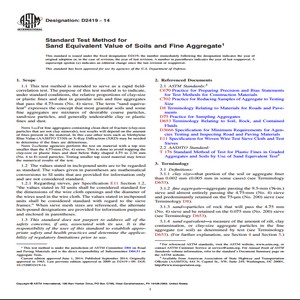ASTM D2419−14 Standard Test Method for Sand Equivalent Value of Soils and Fine Aggregate
ASTM D2419−14 Standard Test Method for Sand Equivalent Value of Soils and Fine Aggregate
Scope
1.1 This test method is intended to serve as a rapid field correlation test.
The purpose of this test method is to indicate, under standard conditions, the relative proportions of clay-size or plastic fines and dust in granular soils and fine aggregates that pass the 4.75-mm (No. 4) sieve.
The term “sand equivalent” expresses the concept that most granular soils and some fine aggregates are mixtures of desirable coarse particles, sand-size particles, and generally undesirable clay or plastic fines and dust.
NOTE 1—For fine aggregates containing clean dust of fracture (clay-size particles that are not clay minerals), test results will depend on the amount of fines present in the material.
In this case other tests such as Methylene Blue Value (AASHTO T330) or X-Ray Diffraction (XRD) may be needed to determine if the fines are deleterious.
ASTM D2419−14 Standard Test Method for Sand Equivalent Value of Soils and Fine Aggregate
Significance and Use
5.1 This test method assigns an empirical value to the relative amount, fineness, and character of claylike material present in the test specimen.
5.2 A minimum sand equivalent value may be specified to limit the permissible quantity of claylike or clay size fines in an aggregate.





Reviews
There are no reviews yet.